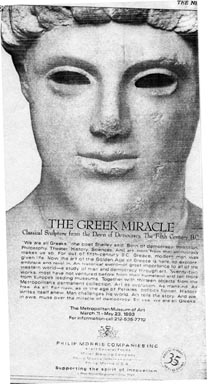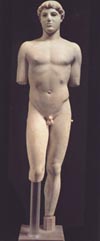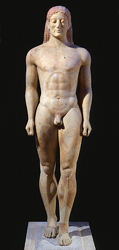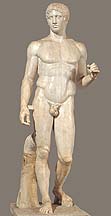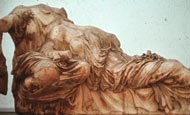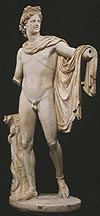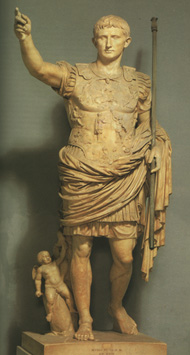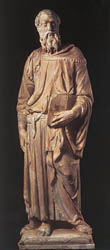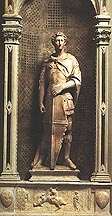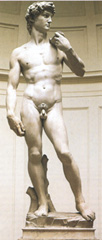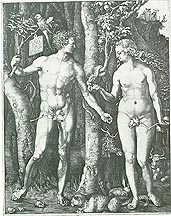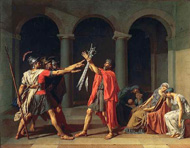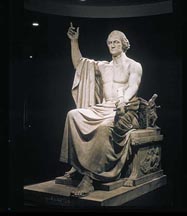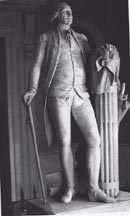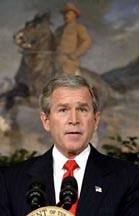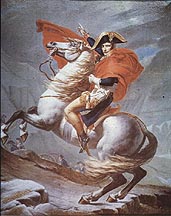ARTH Courses | ARTH 200 Assignments
"Man is the Measure of all Things"- Protagoras of Abdera ( c. 480-410 B.C.)
The advertisement above appeared in the New York Times "Arts and Leisure" section in the Spring of 1993. It announced the opening of a show at the Metropolitan Museum of Art devoted to major monuments of Greek Classical Sculpture. The head shown in the ad is from the so-called Kritios Boy, a work that dates from about 480 B.C. and is a major monument of Early Classical sculpture:
The conception of the show as exemplified by the text included in the ad reflects one of the major "master narratives" Salomon refers to in the introduction of her article on the Venus Pudica. Use the critical perspectives presented in the following quotations from Salomon's article to read the text accompanying the exhibition entitled The Greek Miracle:
| To write history, and perhaps most particularly the history of cultural objects, is to engage in creating coherences. Art historians make sense in (and of) their discipline by connecting objects and events with seamless narratives that appear to tell logical stories. There are several master narratives to choose from, although fewer than one might imagine. Within traditional art history, no more satisfying explanatory connection can be made for a work of art than to link it to classical antiquity. Classical survivals, revivals, rejections, reconstructions and deconstructions are the bread and butter of graduate student papers, dissertations, scholarly articles and university press books... [p. 69]. |
Classical references
can, of course, come in a variety of different shapes and sizes. These
involve a sliding scale from explicit to implicit connections with ancient
art: for example mythological subject-matter, classical form, classical
pose, or classical disposition. Such connections do much more than validate
any work by placing it within a recognizable, and highly prestigious,
historical genealogy. They bestow an instant sense of knowledge and mastery
upon the viewer who sees the connections and place him/her in the league
of a cultural elite. Ever since the Italian Renaissance, the infinitely
elevated regard intellectual gratification produced by the historian's
coherent narratives, which revel in unending reaffirmations of 'classicism'
as the adherent stuff of western culture's 'high' history. The potency
of Greek culture inventions are underscored by the high status conferred
on the whole of classical antiquity in general as a 'reservoir of powerful
archetypal images which lay claim to some privileged kind of truth about
human nature.' From origin to copy, from teacher to student, from generation
to generation, from period to period, the history of western man is made
to cohere along classical values presented as rational, logical, and universalist.
They echo the originary structure of Genesis,  'And
God made man in his own image'. How right it all seems. How logical
and reassuring. Or is it? Or more accurately, for whom is it? [p. 69] 'And
God made man in his own image'. How right it all seems. How logical
and reassuring. Or is it? Or more accurately, for whom is it? [p. 69] |
The Kritios Boy represents one of the first examples of the so-called "contrapposto" pose that will play a central role in narratives of western art.
Breaking away from the mechanical conception of the human figure in earlier traditions of art like Egyptian and Archaic Greek art (see above), the Kritios Boy demonstrates how the artist understood the body works organically with the different parts of the anatomy working interdependently. With the so-called contrapposto pose, the figure manifests weight-shift with the clear differentiation between the weight-bearing and free legs:
In writing about the contrapposto pose, Salomon states: "Standing for the masculine model, the term is explained as rational, mathematical, philosophical, and authoritative." Salomon draws the contrast between the conception of male and female figures in Greek Archaic and Classical art as exemplified in a comparison between the Doryphoros of Polykleitos and reclining goddess from the east pediment of the Parthenon:
Salomon writes: "The male figure is portrayed as coherent and rational from within; the female figure is portrayed as attractive from without; the male body is dynamically explored as an internally logical, organic unity; the female body is treated as an external surface for decoration. The assymetrical treatment of the nude male and clothed female in archaic and classical Greek art can be matched with the by now well-known social and legal inequities between men and women in ancient Athens....[p.71]"
The following is a gallery of works that exemplify the authority of the contrapposto pose in western art:
Augustus of Primaporta, Roman copy c. 20 A.D. of a Roman original of c. 15 B.C.
Michelangelo, David, 1501-4.
Albrecht Dürer, The Fall of Man (Adam and Eve), 1504, engraving.
Jacques Louis David, The Oath of the Horatii, 1784-85.
|
Horatio Greenough, George Washington, 1832-40. (Compare to Pheidias's statue of Zeus in the Temple of Zeus at Olympia. |
August Rodin, The Age of Bronze, 1876.
Jacques Louis David, Napoleon Crossing the St. Bernard Pass, 1800-01. (see also page dedicated to Equestrian Images) |
Caption from Yahoo accompanying the picture above: "President George W. Bush, speaking from the Roosevelt Room of the White House, announces he will endorse a constitutional amendment that would ban gay marriage, February 24, 2004." Behind Bush's head appears a painting of Teddy Roosevelt as a Rough Rider. See this painting in relationship to the western tradition of Equestrian images going back to images of Roman Emperors. In a White House that leaves little to chance, consider the reasons for having the President make this speech in this context with this painting staged strategically behind Bush's head. ---Excerpt from President Bush's speech: "After more than two centuries of American jurisprudence, and millennia of human experience, a few judges and local authorities are presuming to change the most fundamental institution of civilization. Their actions have created confusion on an issue that requires clarity."
Notice the sponsor for the Metropolitan exhibition was the Philip Morris Corporation whose most famous advertising symbol is the "Marlboro Man." Relate your understanding of the imagery associated with this image to the lineage of images traced above. Relate the ideology expressed in the exhibition advertisement to that expressed by the "Marlboro Man."
In his History of Art, H.W. Janson presents the following account of the Doryphoros by Polykleitos:
|
The articulation of the body that appears in the Kritios Boy reached its full development within half a century in the mature Classical style of the Periklean era. The most famous Kouros statue of that time, the Doryphoros (Spear Bearer) by Polykleitos, is known to us only through Roman copies, which must convey little of the beauty of the original. Still, it is instructive to compare this work with the Kritios Boy. Everything is a harmony of complementary opposites. The contrapposto is now more emphatic. The differentiation between the halves of the body can be seen in every muscle. The turn of the head, barely hinted at in the Kritios Boy, is pronounced. The 'working' left arm is balanced by the 'engaged' right leg in the forward position and the relaxed right arm by the 'free' left leg. This studied poise, the precised anatomical details, and above all the harmonious proportions of the figure made the Doryphoros renowned as the embodiment of the Classical ideal of beauty. The ideal here must be understood in a dual sense: as a perfect model and as a prototype. According to one ancient writer, it was known simply as the Canon (rule, measure). The Doryphoros was more than an exercise in abstract geometry. It embodied not only symmetria (structure, proportion) but also rhythmos (composition, movement). Both were basic aspects of Greek aesthetics, derived from music and dance. A faith in ratio can be found throughout Greek philosophy beginning with the Pythagoreans, who believed that the harmony of the universe, like musical harmony, could be expressed in mathematical terms. The Greeks were not the first to explore proportions, of course; the Egyptians had done so earlier. But the Greeks were more systematic in their study, thanks to their passion for abstract numbers, which enabled them to devise the algebraic formulas required for solving complex proportions. This method was beyond the grasp of the Egyptians, who remained wedded to a practical approach. Thus the Greeks easily solved problems that posed great difficulty for Egyptian mathematicians. There is considerable evidence that East Greeks living in Anatolia, along the coast of modern-day Turkey, gained their theoretic bent from Mesopotamia. In fact, Pythagoras' theorem a2X b2=c2 had been solved a thousand years earlier, around the time of Hammurabi. Once they had acquired this tastge for mathematics, the Greeks never lost it. Plato, too, made numbers the basis of his doctrine of ideal forms and acknowledged that the concept of beauty was commonly based on proportion, though he seem to have had little use for art. Polykleitos' faith in numbers also had a moral dimension often found in Classical Greek philosophy, notably that of Plato. Contemplation of harmonious proportions was equated with contemplation of the good. To the Greeks, pose and expression reflected character and feeling, which revealed the inner person and, with it, arete (excellence or virtue). Thus the lowered gaze of the Doryphoros may be seen as denoting modesty, a chief virtue of the Classical Greeks. Rather than being opposed to naturalism, this moral dimension was linked to a more careful treatment of form that makes the human figure appear more lively as well as more real. Classical Greek sculpture appeals to both the mind and the eye, so that human and divine beauty become one. No wonder that figures of victorious athletes have sometimes been mistaken for gods! [with Anthony Janson, sixth edition, pp. 124 & 126] |
